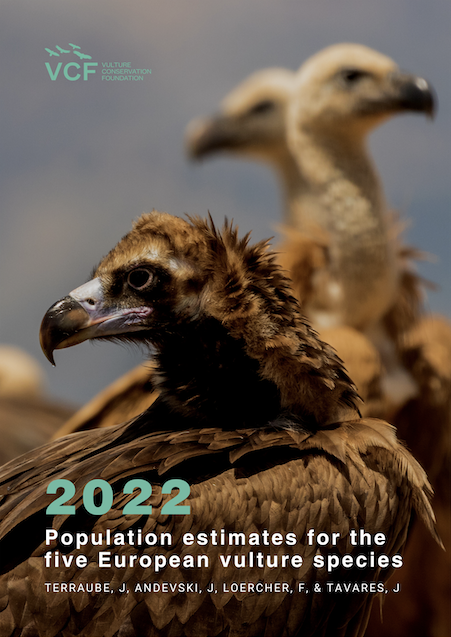
A new report on the latest vulture population estimates across Europe and adjacent Mediterranean countries assesses the conservation status of vulture species and provides recommendations to help ensure their recovery.
Monitoring for conservation
Population monitoring is a crucial task to better assess the conservation status of species and how they respond to threats and global environmental changes. Monitoring at the international level is particularly important for wide-ranging species such as vultures that can perform long-distance foraging movements and cross regularly administrative frontiers while looking for ungulate carcasses. In addition, a thorough evaluation of the effectiveness of long-term conservation actions aimed at vulture population recovery requires the regular collection of population size estimates. In Europe, a strong network of diverse conservation NGOs, governmental organizations and citizens has been involved in monitoring vulture populations over years. Population estimates of European vulture species are annually compiled and available at the national level besides other important demographic parameters such as productivity.
Therefore, the Vulture Conservation Foundation has consistently engaged with these partners over the years to ensure regular updates of vulture population estimates at the European level. The time has come for a new update of vulture breeding numbers in 2022. Our local partners have shared the estimates of vulture population size from 2021 across Europe (EU member states + North Macedonia, Serbia and Switzerland) and adjacent Mediterranean countries including Algeria, Egypt, Israel, Lebanon, Libya, Morocco, Tunisia and Turkey.
Generally positive news
Our new estimates show that, overall, populations of the Bearded, Griffon and Cinereous Vultures showed positive dynamics across most European countries. For example, Griffon Vulture populations have experienced large increases in Serbia, Bulgaria and Portugal and moderate increases in Spain, France and Italy since the last update. Similarly, populations of Cinereous Vulture have been increasing in France, Portugal and Spain while the Greek population seems to remain stable. Moderate increases in Bearded Vulture populations have been reported in Austria, France, Italy and Spain partly as a result of ongoing reintroduction projects.
The Egyptian Vulture remains the most vulnerable vulture species in Europe as the recovery seems to recently have stalled in several countries. For example, populations are stable across the Balkan countries (Albania, Bulgaria, Greece and North Macedonia). The total number of breeding pairs in France has even been recently decreasing, particularly in the West Pyrenees. The Spanish population, the most important numerically in Europe, was considered as stable or slightly increasing but recorded contrasted dynamics at local scales: for instance, populations have declined in Aragon, Castilla-y-Leon and Extremadura while increases were recorded in neighbouring autonomous communities.
European vulture species are now five!
For the first time, we have decided this year to add officially the Rüppell’s vulture as the fifth European vulture species in our global population assessments. This follows several records of mixed breeding attempts involving Rüppell and Griffon Vultures in Southern Spain.
The fact that populations of this Critically Endangered vulture have been declining steeply in Africa while expanding their range to Southern Europe is extremely interesting and calls for further monitoring and research.
Pervasive anthropogenic threats
The positive dynamics highlighted in this new report should not make us forget that threats to vulture populations are well present across European countries. Worrying declines at a local scale such as the ones recorded for the Egyptian Vulture in France and Spain remind us that vulture populations are still vulnerable and that decades of conservation efforts can be overturned quickly by (re)emerging anthropogenic threats such as poison and electrocutions-collisions with energy infrastructure. The recent losses of several Cinereous Vultures, part of a reintroduction project, that were poisoned in Bulgaria is a perfect example of this situation.
Continued monitoring and implementation of conservation actions are crucial to the long-term recovery of European vultures.
Improve monitoring in Mediterranean countries
This report also highlighted limited monitoring efforts of vulture populations in North African countries and Turkey. Yet, Turkey holds substantial breeding populations of Egyptian, Bearded and Cinereous Vultures that are supposedly declining.
Similarly, Egyptian and Bearded Vultures in Morocco are on the verge of extinction while very little information is available on the distribution and population dynamics of these species in the country. Therefore, the VCF calls for increased international collaboration to fill these knowledge gaps and improve vulture monitoring and conservation in these countries.
Finally, we would like to thank all the VCF partners that have contributed to this report by sharing their national estimates. These contributions are invaluable. All names and affiliations of contributors and associated LIFE projects (if relevant) were cited at the end of the report.



